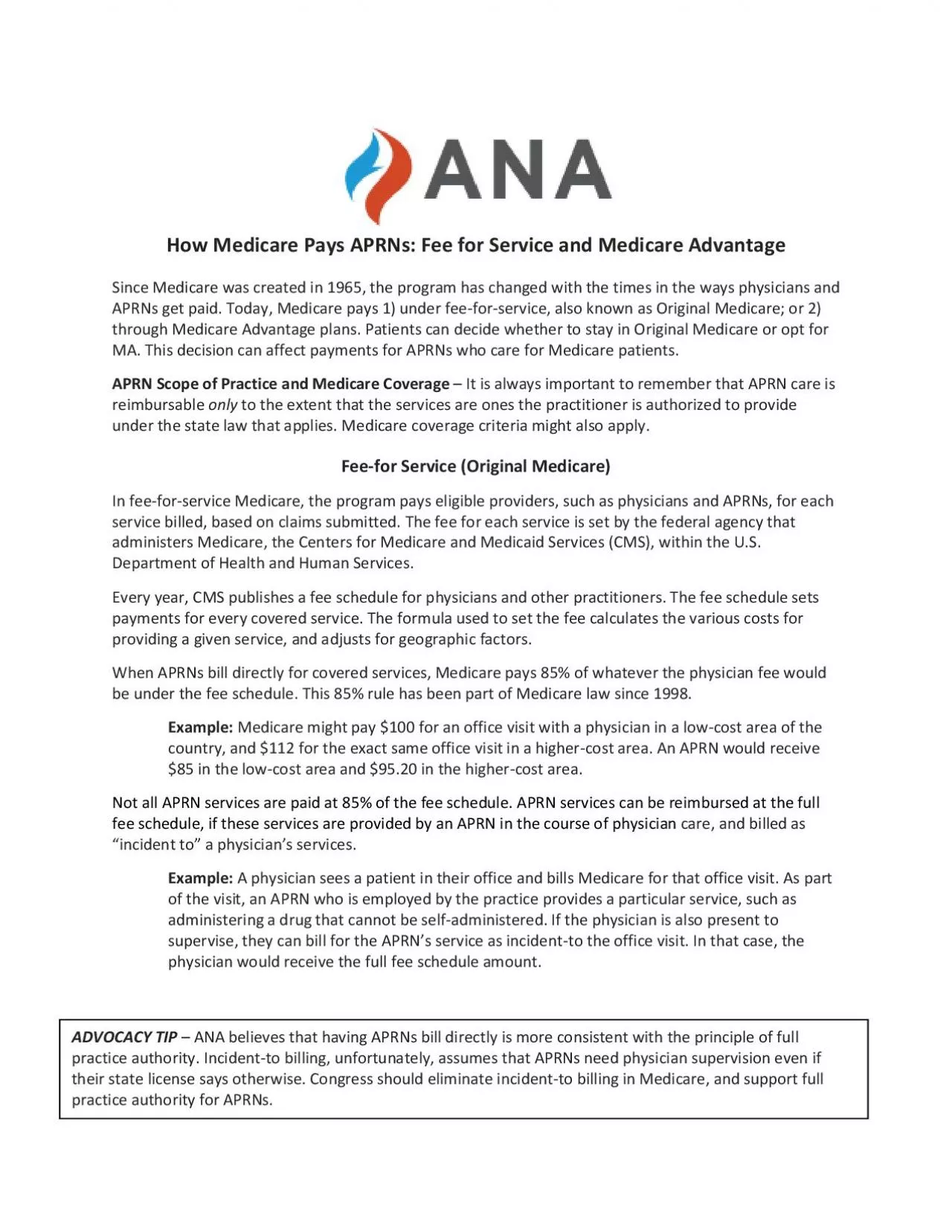

APRNs Fee for Service and Medicare Advantage Since Medicare was created in 1965 the program has changed with the times in the ways physicians and APRNs get paid Today Medicare pays 1 unde ID: 954760
Download Pdf The PPT/PDF document "How Medicare Pays" is the property of its rightful owner. Permission is granted to download and print the materials on this web site for personal, non-commercial use only, and to display it on your personal computer provided you do not modify the materials and that you retain all copyright notices contained in the materials. By downloading content from our website, you accept the terms of this agreement.
How Medicare Pays APRNs : Fee for Service and Medicare Advantage Since Medicare was created in 1965, the program has changed with the times in the ways physicians and APRNs get paid . Today, Medicare pays 1) under f ee - for - service , also known as Original Medicare; or 2) through Medicare Advantage plans . Patients can decide whether to stay in Original Medicare or opt for MA. This decision can affect payments for APRNs who care for Medicare patients. APRN Scope of Practice and Medicare Coverage – It is always important to remember that APRN care is reimbursable only to the extent that the services are ones the practitioner is authorized to p rovide under the state law that applies . Medicare coverage criteria might also apply. Fee - for Service (Original Medicare) In fee - for - service Medicare, the program pays eligible providers , such as physicians and APRNs, for each service billed, based on claims submitted. The fee for each service is set by the federal agency that administers Medicare , the Centers for Medicare and Medicaid Services (CMS), within the U.S. Department of Health and Human Services. Every year, CMS publishes a fee schedule for physicians and other practitioners. The fee schedule sets payment s for every covered service. The f ormula used to set the fee calculates th e various cost s for provid ing a given service, and adjusts for geographic factor s. When APRN s bill directly for covered services, Medicare pays 85% of whatever the physician fee would be under t he fee schedule . This 85 % rule has been part of Medicare law since 1998. Example: Medicare might pay $100 for an office visit with a physician in a l
ow - cost area of the country, and $112 for the exact same office visit in a higher - cost area. An APRN would receive $85 in the lo w - cost area and $95.20 in the higher - cost area. Not all APRN services are paid at 85 % of the fee schedule. APRN services can be reimbursed at the full fee schedule, if these services are provided by an APRN in the course of physician care, and billed as “incident to” a physician’s services. Example: A physician sees a patient in their office and bills Medicare for that office visit. As part of the visit, a n APRN who is employed by the practice provid es a particular service, such as administerin g a drug that cannot be self - administered. If the physician is also present to supervise, they can bill for the APRN’s service as incident - to the office visit. In that case, the physician would receive the full fee schedule amount. ADVOCACY TIP – ANA believes that having APRNs bill directly is more consistent with the principle of full practice authority. Incident - to billing, unfortunately, assumes that APRNs need physician supervision even if their state license says otherwise. Congress should eliminate incident - to billing in Medicare, and support full practice authority for APRNs. Medicare Advantage A growing number of Medicare patients receive care that is paid through a Medicare Advantage (MA) plan. MA is a part of the Medicare law that permits patients to enroll in private plans such as managed care, instead of receiving care on a fee - for - service basis. The minimum benefits are the same in fee for service and MA , though an MA plan might offer extra coverage . Pl ans do not have to contract with all practitioners , and the
y may have their own approach to creating their provider networks . Negotiated payment rates are part of the agreemen t . Unlike Original Medicare, there is no definite rule about how APRNs are paid in MA. Plans may use the Fee Schedule as a reference , but they are not required to do so . There is very little transparency in MA payments to providers, so APRNs have to be their own negotiators. Example: MA Plan XYZ created a provider network to include APRNs on an equal footing with physicians as primary care providers . APRNs and physicians are paid the same, and Medicare patients can choose who they want to see. MA Plan ABC does not recognize APRNs in their provider networks , and patients must choose a physic ian as their primary care provider. For More Information CMS , the Medicare agency, sponsors the Medicare Learning Network, which offers information and education for practitioners. You can search “CMS Medicare Learning Network” or visit the site at this address: https://www.cms.gov/outreach - and - education/medicare - learning - network - mln/mlngeninfo/index.html The Medicare Learning Network has published a booklet for APRNs about coverage and payment policy , which you can access at this address. https://www.cms.gov/Outreach - and - Education/Medicare - Learning - Network - MLN/MLNProducts/Downloads/Medicare - Information - for - APRNs - A As - PAs - Booklet - ICN - 901623.pdf For information about how ANA advocates for APR Ns , contact us at gova@ana. org . Advocacy Tip – ANA believes that Congress and the Administration should encourage MA plans to allow APRNs in their networks and to pay them fairly, so patients have more choice of provider.